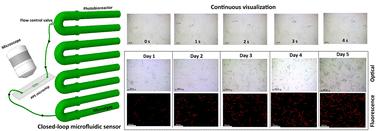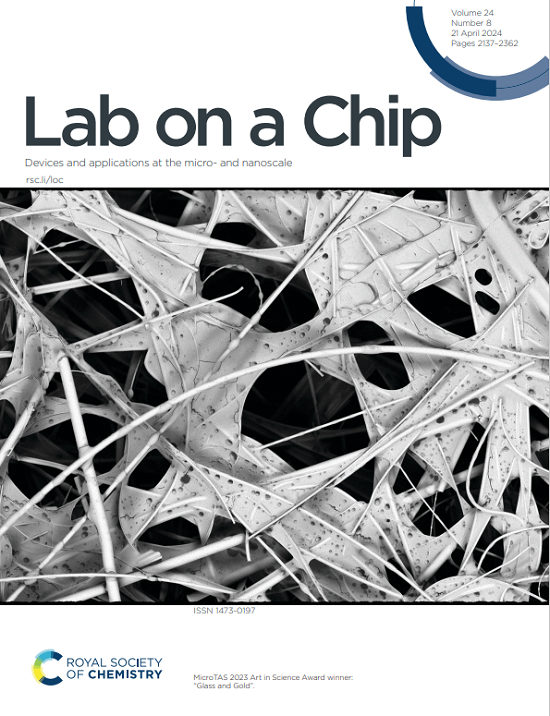An integrated continuous-flow microfluidic sensor for long-term monitoring of microalgae growth in a tubular photobioreactor
IF 5.4
2区 工程技术
Q1 BIOCHEMICAL RESEARCH METHODS
引用次数: 0
Abstract
Spirulina (Arthrospira platensis) is a valuable cyanobacterium used for various applications, including health supplements, cosmetics, biofertilizers, carbon capture, and biofuels. Efficient monitoring of microalgae growth in photobioreactors is crucial for optimizing yields in large-scale culturing. Existing monitoring systems take samples from the bioreactor at different intervals and perform the visualization and quantification of algae growth parameters. In this work, a microfluidic platform is mounted on a tubular photobioreactor, and the system continuously monitors the growth behavior of Spirulina over several days, with algal development captured on demand. Furthermore, the microfluidic sensor is fabricated using a novel xurography-based approach on photopolymer sheets. It captures real-time micrographs of algae continuously for 5 days (over 120 hours) under two different conditions: open-loop and closed-loop. In the open-loop configuration, the sensor hydrostatically taps the algal medium from the bioreactor at regular intervals. In contrast, the closed-loop sensor continuously (24/7) circulates the culture medium through the microchip for visualization without the use of any driving mechanism. From the micrographs, algal cell density, cell count, and trichome length are estimated continuously, and all parameters exhibited an increasing trend over time. Importantly, the cell density obtained from the microfluidic sensor closely matches with the conventional benchmark glass slide method, with an error of less than 3.3%. The microfluidic monitoring platform is found to be low-cost, accurate, fast, and efficient compared to existing systems, and moreover, it is easily amenable to automation.

一种用于长期监测管状光生物反应器中微藻生长的集成连续流微流控传感器
螺旋藻(Arthrospira platensis)是一种有价值的蓝藻,用于各种用途,包括保健品、化妆品、生物肥料、碳捕获和生物燃料。光生物反应器中微藻生长的有效监测对于优化大规模培养产量至关重要。现有的监测系统以不同的间隔从生物反应器中采集样本,并对藻类生长参数进行可视化和量化。在这项工作中,微流体平台安装在一个管状光生物反应器上,该系统连续监测螺旋藻的生长行为数天,并根据需要捕获藻类的发育。此外,微流体传感器是利用一种新的基于光成像的方法在光聚合物片上制造的。它在开环和闭环两种不同的条件下连续5天(超过120小时)实时捕获藻类显微照片。在开环配置中,传感器以流体静力法定期从生物反应器中提取藻类培养基。相比之下,闭环传感器连续(24/7)循环培养基通过微芯片可视化,而不使用任何驱动机制。从显微照片中可以连续估计藻类细胞密度、细胞计数和毛状体长度,所有参数都随时间呈增加趋势。重要的是,从微流体传感器获得的细胞密度与传统的基准玻片法非常接近,误差小于3.3%。与现有系统相比,该微流控监测平台具有低成本、准确、快速、高效、易于自动化的特点。
本文章由计算机程序翻译,如有差异,请以英文原文为准。
求助全文
约1分钟内获得全文
求助全文
来源期刊

Lab on a Chip
工程技术-化学综合
CiteScore
11.10
自引率
8.20%
发文量
434
审稿时长
2.6 months
期刊介绍:
Lab on a Chip is the premiere journal that publishes cutting-edge research in the field of miniaturization. By their very nature, microfluidic/nanofluidic/miniaturized systems are at the intersection of disciplines, spanning fundamental research to high-end application, which is reflected by the broad readership of the journal. Lab on a Chip publishes two types of papers on original research: full-length research papers and communications. Papers should demonstrate innovations, which can come from technical advancements or applications addressing pressing needs in globally important areas. The journal also publishes Comments, Reviews, and Perspectives.
 求助内容:
求助内容: 应助结果提醒方式:
应助结果提醒方式:


